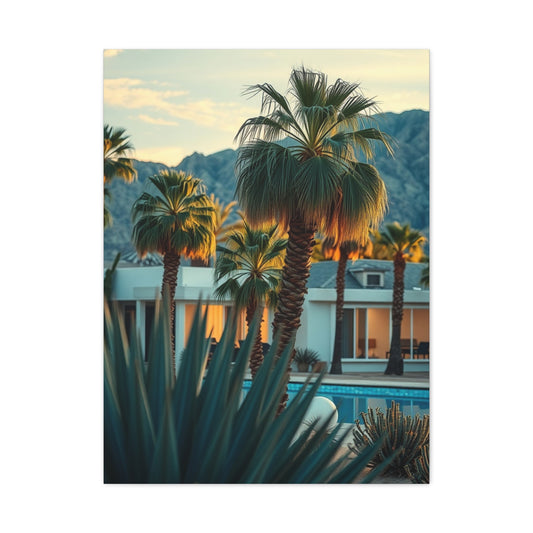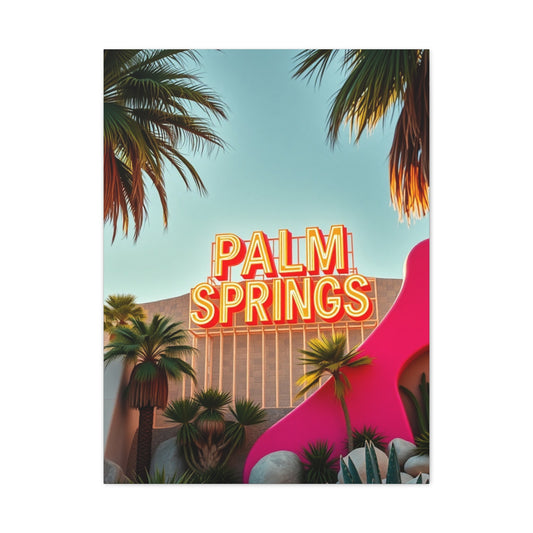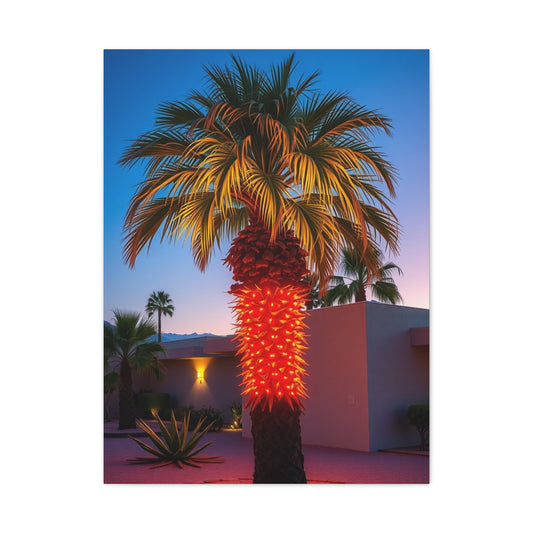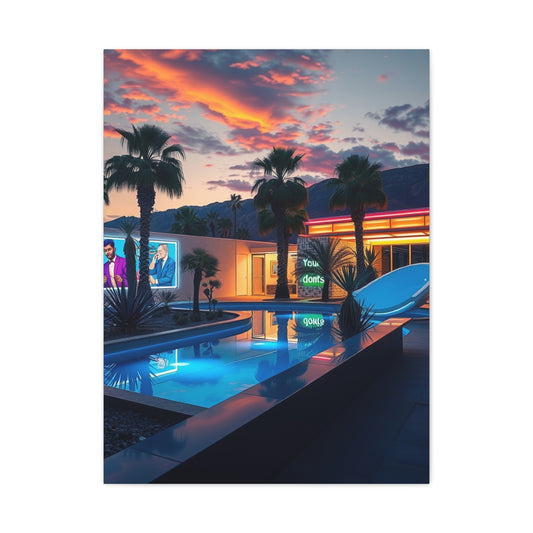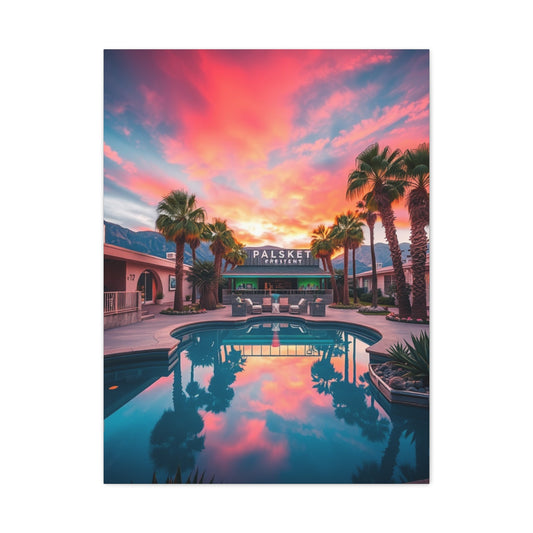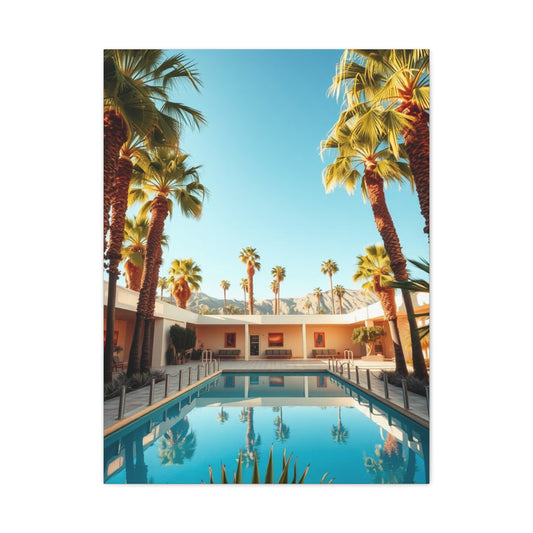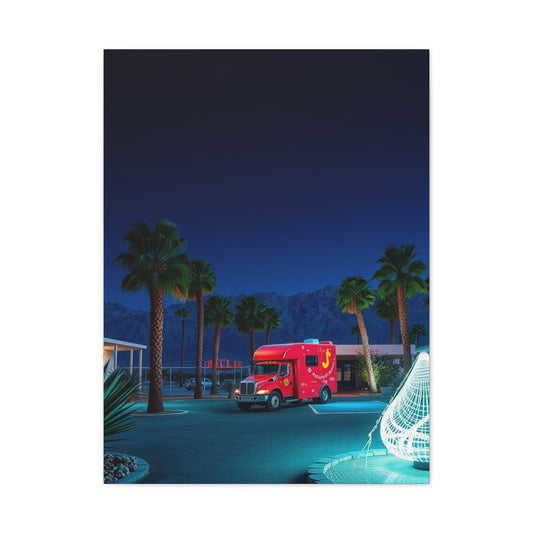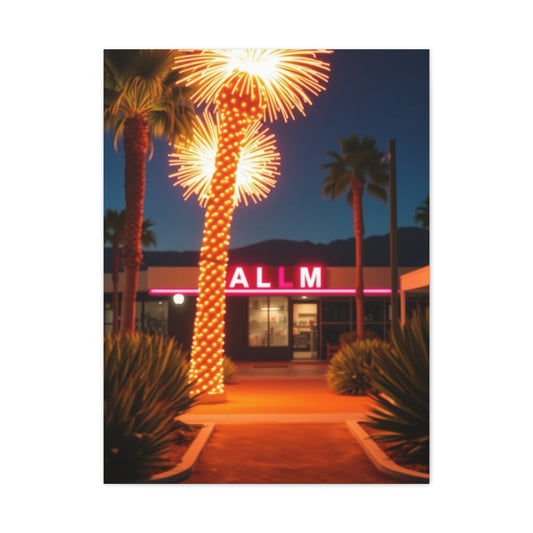Palm Springs Wall Art for a Mid-Century Modern Home
Palm Springs is a place where architectural precision meets the poetry of the desert. Nestled against a dramatic mountain range, this small but influential city has become a cultural symbol of refined leisure, timeless design, and effortless sophistication. Known globally for its mid-century modern homes, boutique hotels, and bold use of color, Palm Springs offers more than just a vacation retreat. It represents a lifestyle, one that harmonizes modern design with the wild beauty of the arid landscape. What makes Palm Springs especially distinctive is its ability to merge the clean, angular lines of mid-century modern architecture with organic elements such as palm groves, cacti, and sweeping desert skies. The juxtaposition of nature’s irregular forms with human-made geometry produces an aesthetic unlike any other. These visual dialogues have long captivated photographers, designers, and collectors, eventually finding their way into the world of wall art. Whether through vibrant photography prints of colorful doors or minimalist depictions of desert flora, Palm Springs-inspired wall art translates this unique sense of place into objects that can transform any home. The influence of Palm Springs extends well beyond its geography. What began as a mid-20th-century architectural experiment has evolved into a globally admired aesthetic. Interior designers reference it, collectors covet its representations, and homeowners worldwide seek to capture its laid-back yet sophisticated aura through curated décor. In this way, Palm Springs has become both a physical destination and a cultural motif—a source of artistic and architectural inspiration that continues to thrive in wall art, design, and lifestyle trends.
Historical Background
The origins of Palm Springs as a design icon can be traced back to the post-war years when America entered a period of optimism, prosperity, and expansion. During the 1940s and 1950s, architects were drawn to the desert for its unspoiled terrain and endless sunlight. They found in Palm Springs a blank canvas where they could experiment with new materials, daring concepts, and novel ways of blending indoor and outdoor living. Mid-century modern architecture, the style that defined Palm Springs, emphasized function, simplicity, and a deep respect for nature. The desert landscape became more than a backdrop; it was a partner in design. Large windows framed the surrounding mountains, flat roofs mimicked the horizon line, and outdoor patios extended the home’s footprint into nature. This seamless integration became one of the hallmarks of the Palm Springs identity. The community attracted both creative minds and cultural figures. Hollywood stars built vacation homes here, architects such as Richard Neutra and Albert Frey pioneered experimental designs, and photographers began documenting the evolving landscape of modernism. The result was a city that became synonymous with modern leisure and artistic ambition. This history is preserved today not only in architecture but also in visual culture. Vintage photographs, artistic prints, and contemporary wall art continue to celebrate the legacy of this period. When one sees a framed photograph of the Pink Door House or a stylized print of palm trees swaying against a modernist facade, it is more than decoration—it is a homage to decades of architectural daring and cultural innovation.
Core Concepts and Foundations
At the heart of Palm Springs’ aesthetic lies the philosophy of balance. The architects of the mid-century modern movement were not only concerned with how structures looked but also with how they interacted with their surroundings. This idea permeates the foundations of Palm Springs design and explains why it remains so resonant in wall art today. One key concept is transparency. The use of glass walls and expansive windows allowed interiors to merge seamlessly with exteriors, dissolving the boundaries between domestic life and the desert beyond. In wall art, this is often represented through images that emphasize openness—photographs of wide courtyards, or prints that capture reflections of sky and mountain in sleek glass facades. Another defining principle is geometry. Mid-century modern homes in Palm Springs are built on clean lines, angular planes, and carefully proportioned forms. The precision of this geometry pairs elegantly with the organic asymmetry of palm trees and desert flora. Artists often highlight this contrast, producing photography prints and wall art that celebrate both the human hand and nature’s spontaneity. Color also plays a crucial role. While many homes maintain a minimalist palette of whites and neutrals, bursts of vibrant hues in the form of painted doors or poolside décor provide playful counterpoints. This has created a cultural iconography that translates beautifully into art. The image of a turquoise door framed by a whitewashed wall or a hot-pink entrance contrasted against desert stone has become timeless. These foundations remind us that Palm Springs is not merely about architecture—it is a design philosophy that extends into interior decoration, lifestyle choices, and visual expression. Wall art inspired by this region distills these principles into a form that can travel far beyond the desert, enriching homes across the globe.
Types and Categories
Palm Springs-inspired wall art encompasses a wide range of forms, each capturing different aspects of the city’s aesthetic. The diversity of these categories allows collectors and homeowners to choose art that resonates with their personal sense of style while still echoing the spirit of the desert. One prominent category is architectural photography. This includes striking images of iconic Palm Springs homes, hotels, and landmarks. Prints featuring the famous Pink Door House, the angular shadows of modernist facades, or the bold colors of Hotel Saguaro are instantly recognizable and serve as emblems of the city’s identity. Another category highlights natural elements. Desert landscapes, cactus gardens, and towering palms are often the subjects of wall art that celebrates the organic beauty of the environment. These works often evoke a sense of tranquility and timelessness, providing balance to more geometric or architectural prints. A third category merges both architecture and nature. These artworks show how modern homes are cradled within the desert landscape, emphasizing harmony and coexistence. A photograph of a sleek poolside patio against the rugged mountains, for instance, conveys the precise balance Palm Springs has always pursued. Colorful door photography has become a category of its own. The bold doors painted in vivid hues against neutral walls are not just functional entrances but cultural symbols. Wall art that captures these doors embodies both playfulness and sophistication, making them conversation pieces within any interior. Finally, abstract interpretations of Palm Springs round out the spectrum. Artists may reduce the aesthetic to color blocks, stylized palm fronds, or geometric patterns that capture the essence of desert modernism without literal representation. These artworks appeal to those who want to bring the mood of Palm Springs into their home in a more interpretive way.
Practical Applications
The influence of Palm Springs design is not confined to Southern California. Through wall art and photography prints, its spirit travels into homes, offices, and public spaces across the world. Integrating Palm Springs-inspired art into interiors requires both intention and balance. For living rooms, a large architectural print can serve as a focal point, anchoring the space while also infusing it with desert sophistication. A photograph of a modernist facade with palm trees stretching upward provides both structure and organic vitality. In bedrooms, softer interpretations—such as minimalist desert landscapes or muted prints of cactus gardens—create a sense of calm and retreat. Hallways and transitional spaces are ideal places to feature Palm Springs’ colorful doors. Their playful vibrancy enlivens narrow or overlooked areas, transforming them into engaging design moments. Kitchens and dining areas can benefit from abstract wall art inspired by Palm Springs’ palette, introducing energy without overwhelming the environment. The versatility of Palm Springs wall art also extends to commercial spaces. Hotels, cafes, and creative offices often draw upon its aesthetic to convey both modern elegance and a sense of escape. A set of photography prints depicting the Hotel Saguaro or the Blue Door House, for example, can evoke sophistication while also sparking curiosity and conversation. When choosing Palm Springs-inspired artwork, attention should also be paid to scale, framing, and finish. Larger prints can transform an expansive wall, while smaller series work well in clusters. The choice between glossy and matte finishes alters how light interacts with the art, echoing the very principles of transparency and reflection central to mid-century modern design. Ultimately, the practical application of Palm Springs wall art is about bringing balance, playfulness, and harmony into a space. By choosing pieces that celebrate the dialogue between modern architecture and the desert landscape, homeowners and designers can create interiors that feel both timeless and contemporary.
Techniques and Methods
The artistry behind Palm Springs wall art lies not only in subject matter but also in the techniques used to capture and present it. The most celebrated works rely on photography, yet even within this medium there exists a spectrum of methods that shape mood, detail, and resonance. High-resolution digital photography has opened new possibilities for capturing the crisp geometry of mid-century modern facades and the saturated hues of desert skies. Photographers often work with wide-angle lenses to encompass the sweeping horizontality of Palm Springs architecture, ensuring that the interplay between structure and backdrop is fully expressed. Drone photography has introduced a fresh perspective, allowing viewers to see how iconic homes and hotels sit within the arid terrain, framed by clusters of palms and jagged mountain ridges.
Printing methods are equally significant in defining the final effect. Traditional photographic prints on fine art paper remain popular for their tactile qualities and nuanced tonal range. However, modern canvas prints have become a preferred choice for many collectors and homeowners because they provide depth, durability, and a painterly texture that complements the organic-meets-modern ethos of Palm Springs design. Acrylic and metal prints lend a sleek contemporary finish, enhancing the luminosity of vivid colors and reflective surfaces that echo the gleam of glass walls and sunlit pools. The choice of medium can transform the perception of the same image, highlighting either its softness and intimacy or its sharpness and modernity.
Framing is another method that shapes the experience of wall art. Minimalist frames in natural wood or matte finishes echo the clean lines of mid-century modern design, while bold frames in metallic hues introduce an element of glamour reminiscent of Palm Springs’ heyday as a Hollywood retreat. Some collectors favor frameless presentations, allowing the artwork itself to float against the wall, reinforcing the sense of openness central to the aesthetic.
Beyond photography, mixed media techniques are gaining traction. Artists combine photography with painting, digital collage, or graphic design to reinterpret familiar Palm Springs motifs. A colorful door might be overlaid with abstract geometric patterns, or a desert landscape rendered in stylized gradients that highlight its sculptural qualities. Such experimentation underscores the versatility of Palm Springs imagery and keeps it alive within contemporary artistic discourse.
Lighting is often considered a finishing method, yet it is integral to how wall art is perceived. Photographs of Palm Springs homes and landscapes are deeply tied to light—the golden glow of desert sunsets, the sharp contrasts of midday sun, the ethereal stillness of twilight. Proper display lighting replicates these effects, bringing out subtleties in texture and tone. Adjustable track lighting or wall-mounted fixtures can be positioned to highlight architectural lines or create gentle shadows that mimic the desert’s natural atmosphere.
Challenges and Common Mistakes
Despite its adaptability and enduring appeal, incorporating Palm Springs wall art into interiors is not without pitfalls. One of the most common mistakes is over-saturation. Because the imagery often involves bold colors and striking contrasts, filling a room with too many vibrant prints can overwhelm the space, leading to visual fatigue rather than harmony. Balance is key. Pairing a colorful door print with subtler desert landscapes or black-and-white architectural studies ensures diversity without chaos.
Another challenge arises in scale. Selecting artwork that is too small for a large wall diminishes its impact, while oversized prints in cramped areas may feel oppressive. Proper proportion is essential, mirroring the architectural principle that guided Palm Springs design itself—forms must be in balance with their surroundings. Similarly, inappropriate framing can diminish the effect of a piece. Heavy ornate frames, for instance, clash with the clean, modern lines central to Palm Springs aesthetics, distracting from the imagery rather than enhancing it.
A frequent oversight involves context. Palm Springs imagery resonates because it embodies a dialogue between architecture and nature. When introduced into interiors that disregard this dialogue, the result can feel disjointed. For instance, placing a vivid turquoise door print in a space filled with ornate classical furnishings may create discord. This does not mean that Palm Springs wall art requires minimalist interiors exclusively, but rather that its integration should be thoughtful, ensuring that surrounding elements complement rather than compete.
Lighting missteps are also prevalent. Glossy prints displayed in poorly lit spaces can suffer from glare, diminishing their visual impact. Conversely, insufficient light can flatten images, stripping them of depth and vibrancy. As light plays such a pivotal role in desert environments, it must be considered carefully in interiors showcasing Palm Springs art.
Finally, a common conceptual mistake is treating wall art as an afterthought rather than an integral design element. In Palm Springs, architecture and art were never separate—they existed as parts of a holistic vision. To relegate wall art to secondary status risks missing the opportunity to create interiors that truly capture the spirit of this unique aesthetic.
Trends and Future Outlook
Looking ahead, the trajectory of Palm Springs wall art reveals several promising trends that align with broader cultural currents. Sustainability is at the forefront, with growing demand for eco-friendly production methods. Collectors are increasingly aware of the environmental footprint of art, seeking works printed with organic inks, recycled paper, and responsibly sourced frames. This focus aligns perfectly with the ethos of Palm Springs itself, which has always emphasized harmony between human creation and the natural landscape.
Personalization continues to shape the market. Advances in printing technology now make it possible for buyers to request custom dimensions, unique color treatments, or curated series tailored to their spaces. This personalization ensures that Palm Springs wall art remains not only a universal aesthetic but also a personal statement, reflecting individual taste while retaining its iconic imagery.
Hybrid media is another trend expanding the possibilities of this genre. Digital artists are experimenting with overlays, animations, and interactive features that reinterpret Palm Springs motifs in innovative ways. Augmented reality allows viewers to experience art that shifts under different lighting or reveals hidden layers when viewed through digital devices. These approaches echo the experimental spirit of mid-century modernists, who themselves embraced new technologies in design and construction.
Cultural cross-pollination is also on the rise. Palm Springs wall art is no longer confined to American interiors but is inspiring design narratives globally. In Europe, it complements Scandinavian minimalism by adding warmth and vibrancy. In Asia, it pairs with contemporary urban aesthetics, providing a touch of natural serenity. This global diffusion ensures that Palm Springs imagery will continue to evolve, absorbing and influencing diverse cultural contexts.
Looking further into the future, the outlook suggests that Palm Springs wall art will remain relevant precisely because it embodies balance. As design oscillates between maximalism and minimalism, digital and tactile, global and local, the Palm Springs aesthetic offers a steady anchor that celebrates simplicity, harmony, and joy.
Expert Insights
Designers, architects, and collectors consistently highlight the enduring relevance of Palm Springs wall art. Many emphasize its adaptability. Interior designer Clara Mendoza notes that the appeal lies in its duality: “Palm Springs art can be a statement piece or a subtle accent. It adapts because it is built on principles of balance that are timeless.” Similarly, architectural historian Samuel Turner points to its historical resonance: “Every photograph of a colorful door or modernist facade carries with it the story of mid-century innovation, of architects who sought to merge living spaces with the desert environment.”
Photographers working in Palm Springs today describe their process as one of reverence and experimentation. For instance, contemporary artist Leona Drake explains that she seeks to capture the “quiet dialogue between desert stillness and architectural rhythm,” often waiting hours for the perfect alignment of shadow and light. Collectors, too, express the emotional connection. Many cite the sense of tranquility and optimism evoked by Palm Springs imagery as a key reason for its enduring popularity. One collector remarked that a simple print of palm silhouettes against a twilight sky “transports me instantly into a state of calm, no matter how chaotic the day.”
Experts also warn of misinterpretations. Interior consultant James Hollander suggests that while Palm Springs art is visually striking, it should not be reduced to mere trend-following. “Its real strength lies in the philosophy it represents—the belief that human design and natural beauty can coexist. To ignore that is to miss its essence.” This perspective underscores the importance of thoughtful integration, ensuring that Palm Springs wall art is not treated as decorative fashion but as part of a larger cultural and design heritage.
As experts continue to reflect on its significance, it becomes clear that Palm Springs wall art is not a fleeting phenomenon but a sustained conversation between past and present, between desert landscape and modern architecture, between nostalgia and innovation. Its relevance endures because it speaks to universal human desires for beauty, balance, and connection.
Emerging Trends in Wall Art
The landscape of wall art has shifted dramatically in recent years, reflecting broader cultural changes, evolving aesthetics, and advances in technology. Palm Springs, with its mid-century modern legacy and desert-inspired motifs, continues to serve as a muse for many of these developments. One of the most noticeable trends is the blending of nostalgia with contemporary execution. Homeowners and designers are increasingly drawn to pieces that capture the timeless spirit of Palm Springs architecture and landscapes but present them through modern printing methods, experimental framing, or oversized formats that feel distinctly current. Photography prints of colorful doors, sleek poolside vistas, and desert flora are not simply captured as archival images but reimagined in high-resolution formats that accentuate every hue and detail.
Sustainability has also emerged as a critical influence in wall art trends. Collectors and decorators are seeking works that not only look beautiful but also align with values of environmental stewardship. This is particularly relevant when considering Palm Springs wall art, as its essence lies in harmonizing human creativity with the natural desert landscape. Many artists and studios now produce limited-run prints on recycled or responsibly sourced materials, ensuring that the visual homage to Palm Springs’ beauty does not come at the expense of the environment that inspired it.
Personalization is another rising phenomenon. Rather than settling for mass-produced reproductions, individuals are gravitating toward custom photography prints that capture either their own experiences in Palm Springs or unique perspectives of its iconic sites. A traveler might commission a photographer to immortalize their stay at a historic mid-century villa, while a design enthusiast may choose a piece that spotlights a less famous but equally striking modernist residence. This trend emphasizes individuality while celebrating the city’s diverse architectural vocabulary.
The digital age has further transformed how wall art is consumed and displayed. Virtual galleries, online curation platforms, and augmented reality applications allow buyers to visualize Palm Springs-inspired pieces on their walls before purchase. This fusion of technology and design resonates with the forward-thinking ethos of mid-century modernism, which always embraced innovation alongside aesthetic integrity. Emerging artists now experiment with mixed media, layering photography with abstract digital elements that echo the geometry of modernist facades or the textures of the desert. The result is a hybrid aesthetic that feels both rooted in tradition and entirely of the present moment.
Color trends are also evolving. While Palm Springs has always been associated with bright, playful hues, current interpretations often experiment with more nuanced palettes. Soft terracottas, muted sage greens, and sun-bleached yellows are being integrated into wall art, reflecting a desire for serenity and subtlety in interiors. Yet the iconic vibrancy of turquoise doors and pink facades remains ever-present, ensuring that Palm Springs wall art continues to offer a spectrum of moods and atmospheres suitable for different spaces.
Step-by-Step Guides
Translating the Palm Springs aesthetic into your own space requires a thoughtful approach. While trends highlight the direction in which wall art is evolving, applying them effectively involves a careful process that balances personal taste, architectural context, and practical considerations. The first step is observation. Before selecting pieces, immerse yourself in the essence of Palm Springs design by studying its architecture, its desert landscape, and the interplay between natural and constructed elements. Notice how geometric facades stand alongside organic palm silhouettes or how colorful doors create a striking punctuation mark against neutral exteriors. This initial immersion helps you develop a visual vocabulary that guides your choices.
The next step involves identifying the role of wall art within your space. Some rooms benefit from a commanding focal point, while others require subtle accents that harmonize with existing décor. In living rooms with expansive walls, a large-scale photography print of a mid-century modern home framed by desert mountains can anchor the entire space. Conversely, in more intimate areas such as bedrooms or hallways, smaller series of colorful door prints or abstract interpretations of desert flora may provide the right balance without overwhelming.
Once the role is defined, consider the dialogue between artwork and color palette. Palm Springs wall art thrives on contrasts—neutral walls punctuated by vibrant hues or bold architecture softened by natural textures. To achieve harmony, assess the tones already present in your furniture, textiles, and flooring. If your space leans minimalist, an artwork featuring saturated colors like turquoise, coral, or mustard can enliven the atmosphere. If your interiors already contain strong hues, opt for prints with subdued desert-inspired tones that create equilibrium.
Framing is another crucial step. The choice of frame can either reinforce or dilute the Palm Springs aesthetic. Clean, minimal frames in white, black, or natural wood complement the modernist ethos, while metallic finishes introduce a touch of glamour reminiscent of the city’s golden age as a Hollywood retreat. The proportion of matting also influences perception—wider mats emphasize openness, echoing the expansive desert horizon, whereas narrower mats draw the eye more directly to the image.
Lighting is often overlooked but profoundly affects how wall art is experienced. Natural light enhances the authenticity of Palm Springs imagery, especially when it highlights textures such as stucco walls or the shimmer of desert pools captured in photography. In spaces with limited daylight, consider installing adjustable track lighting that can be angled to reduce glare and accentuate depth. The play of light on glossy versus matte finishes alters mood, so it is worth experimenting to achieve the desired atmosphere.
Placement is the culmination of the process. Think beyond conventional spots above sofas or beds. Palm Springs-inspired art thrives in unexpected locations as well. A colorful door print in a narrow hallway transforms it into an engaging passageway. A desert landscape in a kitchen provides calm while cooking. Even bathrooms can be elevated with serene imagery of palms and mountains, turning utilitarian spaces into design statements.
The final step is integration. Wall art should not exist in isolation but as part of a cohesive interior narrative. Complement your chosen pieces with accessories, textiles, and even plants that echo the imagery. A print of the Pink Door House might be paired with cushions in matching hues, while a desert landscape could inspire the inclusion of succulents or ceramics in earthy tones. This layered approach ensures that the Palm Springs aesthetic feels intentional and immersive rather than incidental.
By following this step-by-step process, homeowners can move beyond simply purchasing art to curating experiences within their spaces. Palm Springs wall art, when thoughtfully chosen and integrated, becomes more than decoration. It becomes a window into an enduring design philosophy that unites modern innovation with desert tranquility.
Integrating Palm Springs Wall Art into Contemporary Spaces
The true strength of Palm Springs-inspired wall art lies in its versatility. While its roots belong to a particular region and era, its essence transcends boundaries, making it adaptable to a wide variety of contemporary interiors. Integrating these works into modern spaces is not about replicating a museum of mid-century aesthetics but about drawing upon its principles to create harmony, personality, and atmosphere. Palm Springs art flourishes in minimalist homes where expanses of white walls provide the perfect canvas for vibrant prints. A photograph of a turquoise door or a saturated depiction of palm trees against azure skies injects vitality without disturbing the serenity of the room. Conversely, in more eclectic interiors where textures and patterns dominate, Palm Springs wall art can provide balance. A muted desert landscape or a monochromatic study of geometric facades introduces grounding elements that create visual breathing space.
Urban dwellings, far removed from the desert, also benefit from this aesthetic infusion. Apartments with limited access to greenery can evoke the tranquility of open horizons through large-scale photography prints of desert mountains or sunlit courtyards. In offices, the clarity of Palm Springs design translates into focus. Prints of linear facades or architectural studies create an atmosphere of order while the inclusion of palm imagery adds a sense of calm that counterbalances the pressures of productivity. Hotels, restaurants, and public venues have increasingly adopted Palm Springs-inspired wall art to conjure feelings of leisure and escape. Guests entering a lobby adorned with colorful door photography instantly feel transported into an environment that celebrates both modernity and playfulness. Cafés and dining spaces often incorporate desert landscapes to foster warmth and intimacy, while poolside or resort settings embrace the bold vibrancy of Palm Springs motifs to amplify an air of joyful relaxation.
The adaptability of this style is partly due to its dual nature. It is simultaneously nostalgic and modern, playful and serious, architectural and natural. These paradoxes make it fertile ground for reinterpretation in a range of design contexts. By carefully considering scale, placement, and accompanying décor, homeowners and designers alike can integrate Palm Springs wall art into spaces that feel personal yet globally resonant.
The Emotional Resonance of Palm Springs Imagery
Beyond design considerations, Palm Springs wall art holds emotional significance. Its imagery evokes more than visual pleasure; it resonates with memories, aspirations, and moods. For many, the sight of colorful doors framed by whitewashed walls conjures nostalgia for vacations in the desert or dreams of carefree living beneath sunlit skies. For others, the linear symmetry of modernist facades represents stability, order, and the optimism of mid-century innovation. Desert landscapes bring a sense of stillness, reminding viewers of the resilience of life in arid environments and the beauty of simplicity. Palm trees, often silhouetted against wide skies, symbolize freedom and timeless leisure.
Art is powerful because it does not merely decorate but communicates. A print of the Pink Door House may spark conversations among guests, serving as a reminder of Palm Springs’ cultural icons. A photograph of desert cacti glowing at sunset may inspire quiet reflection or an appreciation for the majesty of untouched nature. The integration of such pieces into interiors allows spaces to become not only functional environments but also emotional sanctuaries. This resonance explains why Palm Springs wall art continues to appeal across generations and cultures. Its imagery strikes chords that transcend geography, connecting people to universal themes of balance, tranquility, joy, and beauty.
The Future of Palm Springs Wall Art
As design continues to evolve, so too does the interpretation of Palm Springs imagery. While classic photography remains timeless, future trends are expanding the possibilities of how these works are created and experienced. Digital experimentation is increasingly merging with traditional photography, resulting in layered artworks that reinterpret Palm Springs motifs through abstract shapes, color manipulations, or surreal juxtapositions. Such works honor the original aesthetic while pushing it into contemporary artistic dialogues.
Sustainability will undoubtedly continue to shape the future. Eco-conscious collectors seek art printed with environmentally responsible methods, and many studios are responding with organic inks, recycled papers, and sustainable frames. This aligns seamlessly with the ethos of Palm Springs, where harmony with nature has always been central. Technological integration offers yet another dimension. Augmented reality allows users to project wall art into their spaces virtually, ensuring scale and placement feel authentic before purchase. Some artists are even experimenting with interactive prints that shift appearance under different lighting or reveal hidden elements through digital augmentation, echoing the innovative spirit of Palm Springs itself.
Global accessibility is also redefining the audience for Palm Springs wall art. What was once a regional style admired by visitors is now available to anyone with internet access. Online galleries and international shipping mean that a design enthusiast in Europe or Asia can adorn their home with the same prints that capture the energy of the desert city. This diffusion ensures that Palm Springs continues to inspire far beyond its geographic borders, becoming a truly international design motif.
Conclusion
Palm Springs wall art is more than an aesthetic choice. It embodies the convergence of architecture and environment, of modernist clarity and desert serenity. Born from the vision of mid-century innovators, it continues to evolve, adapting to contemporary trends while preserving its timeless core. The clean lines of modernist facades, the vibrancy of colorful doors, the tranquility of desert landscapes, and the iconic silhouettes of palm trees all contribute to a visual language that is both unique and universally appealing.
The enduring appeal of this art lies not only in its visual impact but also in its emotional resonance. It evokes leisure, optimism, nostalgia, and the balance between human ingenuity and natural wonder. In contemporary interiors, Palm Springs wall art acts as both decoration and dialogue, harmonizing with diverse styles while sparking reflection and conversation. Whether displayed in a minimalist apartment, a bustling café, or a tranquil bedroom, it carries with it the essence of a place that has long symbolized sophistication and ease.
Looking ahead, the fusion of technology, sustainability, and personalization promises to keep this aesthetic vibrant and relevant. As artists reinterpret its motifs and audiences continue to embrace its timeless qualities, Palm Springs wall art will remain a powerful expression of how design and environment can unite to create beauty that resonates across generations. To bring such art into one’s home is to invite not only visual delight but also the spirit of a place where modernism met the desert and gave rise to an enduring legend.


